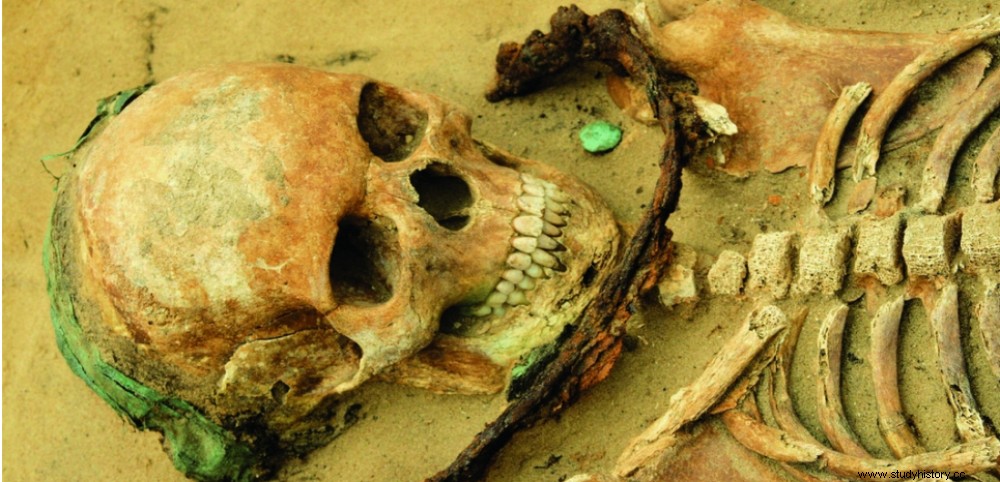 Skeleton with scythe around throat, found in a 17th century Polish cemetery.
Skeleton with scythe around throat, found in a 17th century Polish cemetery. RITUAL. Terror in the face of the unknown? Afraid of "demons"? To face its fears, an old Polish community had found a radical way:to bury certain deceased with sickles under the throat! Five tombs showing this strange ritual were thus recently unearthed in a 17th century cemetery located in Drawsko, as reported in an article published in the journal Antiquity . Marek Polcyn of Lakehead University (Canada) and Elzbieta Gajda of the Czarnkowskiej Museum (Poland) exhumed them among 250 other graves.
These bodies are those of a man aged 35 to 44, two women in their thirties, another in her sixties and a teenager aged 14 to 19. Greenish traces, located near their skulls, indicate that coins had also been placed in their graves, the 60-year-old woman having even been buried with a copper coin in her mouth. Why such special treatment? Did these bodies come to a tragic and violent end? One thing is certain for the time being:they were not strangers. Analyzes of strontium isotopes carried out from dental enamel indeed clearly prove that they are local inhabitants.
Sickles placed in a grave guaranteed that the dead would stay in their coffin and not come back to haunt the living"
This is not the first time that archaeologists have discovered tombs testifying to these rituals. Some have been unearthed in cemeteries as early as the 6th century in Poland, but also in Slovakia, Hungary, Austria, Romania and Germany. Were the deceased involved considered to possess supernatural powers that needed to be combated? "Sickles placed in a grave ensured that the dead would remain in their coffin and not return to haunt the living", explain the archaeologists. A hypothesis confirmed by Claude Lecouteux, historian specializing in medieval civilizations and popular mythology, for whom these practices were reserved for people deemed dangerous for the community. Various rituals have thus been tested:placing huge stones on the chest of the dead or on their heads to prevent them from moving; planting of thorn bushes on the burial so that the shroud remains hung in the branches, preventing the specter from advancing, etc… "The sickle had a double use" , continues the medievalist, iron being a defensive element. The Slavs indeed believed that hard and pointed iron objects, intended to "slash" or "stab", had so-called "apotropaic" virtues, that is to say intended to deflect danger.
Were these deceased considered vampires? The two archaeologists of the publication of Antiquity refute this term, preferring to evoke the great quantity of "demons" which swarmed in the beliefs of central Europe in the Middle Ages. "We are facing what specialists call mutilation of the dead. The recent appearance of vampires in literature, TV series, novels or the press is simply the expression of the emergence of a new myth! Anything buried in a certain way or associated with certain objects is now referred to as a vampire, so much so that translations of popular belief books that once referred to ghosts are now directly transcribed by vampires. " , confirms Claude Lecouteux.
Cultural and behavioral factors, or social stigma due to physical appearance, may have been behind these surprising behaviors. In another study published on this same Polish cemetery by an American team, a cholera epidemic is mentioned in this region in the 17th century. This disease being poorly understood, could its symptoms have been perceived as a supernatural sign?
